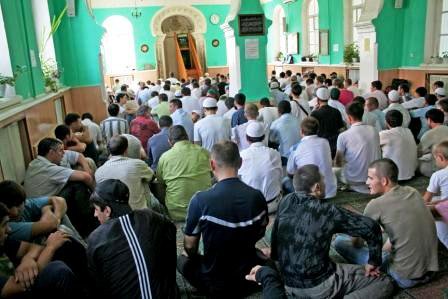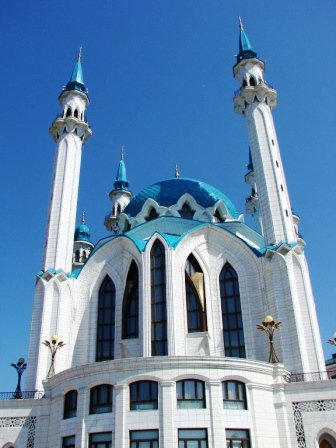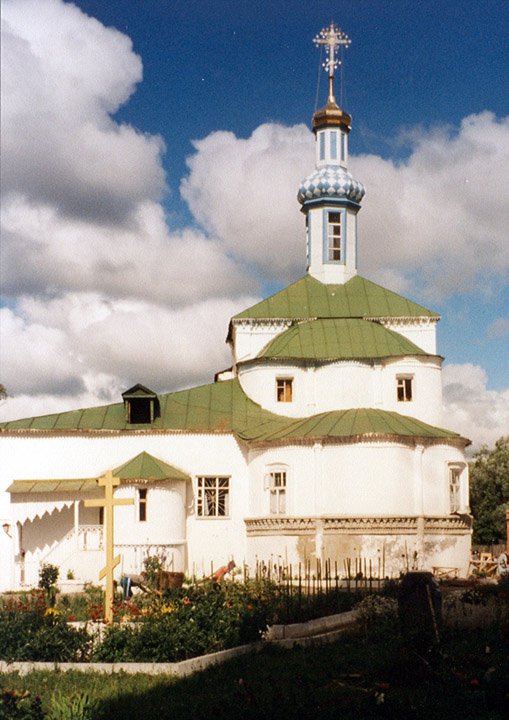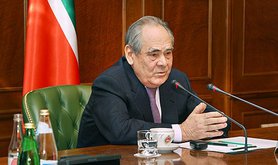On 7 January Orthodox Christians in Russia celebrate Christmas. On this day, as usual, I received many greetings, mostly from my Tatar friends and colleagues. This is customary in Tatarstan. It’s how it has always been.
Until a few years ago the word "tolerance" did not exist in the local vocabulary. I think most locals still have only a vague idea of what it means. In Kazan we don't tend to speak of the friendship of nations or of joint efforts. This is just how people live here, it’s their natural way of behaving and, what probably matters even more, of thinking. And this, I believe, is very important.

Prayer in Burnaev mosque. Kazan is a unique city, where a muezzin's call to prayer from the minaret is followed by the peal of church bells
Even in the Soviet era Kazan was regarded as a unique city, a place where two cultures – Tatar and Russian – intermingle at every step. A muezzin's call to prayer from the minaret is followed by the peal of church bells. This is quite the norm and nobody finds it strange because they have grown up with it. I myself was born in the Old Tatar settlement of Kazan, in a house facing the Burnaev Mosque. In those days the mosque was closed. The only functioning mosque in the entire city, the Mardjani Mosque, was in the next street. Yet the sounds of azan (the call to prayer) could be heard as far as our courtyard. I would hear them on my way to school, followed by the ringing of the bells from the belfry of the Nikolsky Cathedral below the Kazan citadel.
The Khanate of Kazan was annexed by Russia in October 1552, when Tsar Ivan the Terrible conquered the city. From that moment the territory began to be actively settled by Russians. Landowners allocated holdings in this area relocated their peasants here from central parts of Russia. Initially, the Tatars were expelled from the central part of Kazan. They were granted a special area, which formed the basis of what was to become the Old Tatar and the New Tatar settlements. Tatars are very often presented as nomads, dashing horsemen moving from one pasture to the next. In fact, they are settlers who have been cultivating the land for many centuries, a people with a refined culture. The Tatar national cuisine provides ample evidence of this: the staple dishes include the lapsha chicken soup and an incredible variety of delicious pastries. Not to mention chak-chak, the traditional dessert, which is as much a national symbol as bread and salt is for the Russians. Nomadic people have a preference for meat; they had to barter for bread so they have no tradition of baking.
The people inhabiting the area at the confluence of the rivers Volga and Kama received the name Tatars following the conquest of these lands by Genghis Khan's grandson Batu Khan in the 18th century. Before that, the great state of Volga Bulgaria had thrived here since early antiquity. It was this state that adopted Islam in 992, which is how the Moslem faith appeared on the shores of the Volga. Ibn Fadlan, a secretary at the embassy of the Baghdad Khalif al-Muqtadir in the 10th century, wrote a memoir of his travel to these parts, documenting that even in those days the Russians and Bulgarians enjoyed close business and cultural relations. Later on, during the Mongol invasions, both Rus' and Volga Bulgaria ended up as part of a single country, the land of the Golden Horde. The Khanate of Kazan was formed in the 15th century following the disintegration of the Mongol state. From the beginning of the 9th century Kazan was the country's Western frontier, gradually increasing its influence until it was made the capital city after the Mongols’ final destruction of the Bulgarians. This was the city conquered by Ivan the Terrible.
The living conditions of the Russian and Tatar peasants were basically the same. The Tatar ploughman saw that his Russian counterpart had a life that was no better than his own. And this state of things formed the basis for empathy and mutual assistance.
Oleg Pavlov
Russians and Tatars have lived together since then, nearly 500 years. Sometimes the entire period of their co-existence under the Golden Horde is included, adding up to an even longer figure of a thousand years. In either case, over many centuries Tatars and Russians have trod a complicated path to coexistence, and today their peaceful cohabitation is a source of immense pride in Tatarstan for both the Russians and the Tatars, as well as everyone else inhabiting these lands.
Leonid Tolchinsky, who heads Kazan's largest news agency Tatar-Inform, is one of those who believe that the history of interaction between various cultures in this area goes back more than 500 years: «Nations playing different roles, in differing hierarchical combinations and of various dispositions have lived here together as both ethnic and faith groups. Therefore, to use contemporary language, patterns of interaction, mutual respect and tolerance are already established. It is different in Europe, which has found itself inundated by a large Moslem population without being prepared for it. What we have here, by contrast, is a merging of two nations that – even in ancient times – found it hard to work out who was the first to arrive in this territory. Everything has become interwoven». The Tatars are actually the second largest nation in Russia. They live in compact settlements throughout the country – in the Nizhny Novgorod area, in the Urals, in Siberia and in southern Russia.
Dania Tyamaeva, one of the best known Tatar journalists and author of several books on the contemporary history of Tatarstan's numerous administrative districts, believes that this is largely because of the area's geography: peaceful coexistence is much helped by the abundance of space. The region was also rich in forests, water resources and arable land. As a result, people were not in each other's way and their economic development proceeded independently. This, in Tyamaeva's view, is the explanation for the peaceful mentality, which is an important part of good neighbourly and mutually supportive relations. The living conditions of the Russian and Tatar peasants were basically the same. The Tatar ploughman saw that his Russian counterpart had a life that was no better than his own. And this state of things formed the basis for empathy and mutual assistance.

Kazan's Kul Sharif mosque was constructed on the site of an old mosque, which was destroyed when Ivan the Terrible captured the city in 1552.
It is no coincidence that in the late 18th century Tatars took a very active part in the Yemel’yan Pugachov rebellion. The Tatar population did not regard the Russian people as their enemies. In fact, if they considered anyone their enemy, it would have been the representatives of the state and the landowners. The tensest period in their coexistence was probably immediately after the conquest of Kazan in 1552, approximately up until the reign of Empress Catherine II (1762-96). In this period the Tsarist government from time to time made attempts at forcible Christianisation of the Tatars. This policy was not particularly successful. Not even the fact that adopting the Orthodox faith was a condition of being elevated to the ranks of the Russian aristocracy made Tatars eager to convert. On the other hand, there were no impediments to free trade, which they pursued particularly with the countries of the East – roads from Kazan lead to Bukhara, India, Persia and Baghdad. The government even granted Tatar merchants greater privileges than their Russian colleagues.
The Russian and Tatar national character has also played a significant role. The Tatar mentality is completely devoid of aggression. Tatars would rather retreat or step aside than show aggression. Dania Tyamaeva, who grew up in a Tatar village, recalls that children have always been brought up on the saying «If someone throws a stone at you, you throw a piece of bread back». Galya Mukhametshina moved to Kazan relatively recently, in the early 1990s. She was born in a village in the southern Urals, in Chelyabinsk Region. Mukhametshina also recalls lessons from her childhood: «my mum used to say, if strangers come to our village and don't behave well, don’t rush to judge them; after all, they are human beings too.»
As times and mores have changed over the centuries this tolerant attitude gradually began to bear fruit. Empress Catherine II banned attempts at forcible Christianization. Soviet historiography presented the Russian Empire as a «prison of nations». However, it is a little-known fact that under the Tsars two kinds of soldiers' medals were being minted – some with a cross, for the Orthodox, some with a half moon for Moslems. This is no longer the case.
In present day Tatarstan Russians have shown the same tolerant attitude. For the past twenty years the highest ranks of the Republic's leadership have not included anyone with a Slavic name. Although ethnic Tatars comprise some 45% and Russians a further 45% of the Republic's population, the remaining 10% are made up of other nationalities. However, this is not so much a sign of nationalism as the result of the clan and family structure. People understand that.
There is another reason why the non-Tatar inhabitants have shown little open resentment, even if they are not happy about the composition of the Tatarstan government. People often think along the following lines: the Tatars have no other land and this is the only form of state they have in the world. On top of that, we live in the Russian Federation anyway, which has its own Russian government. So for the moment we have nothing to worry about.
Critics of this approach point out that the federal government includes many Tatars, with Rashid Nurgaliev and Elvira Nabiullina holding key portfolios as the Russian Federation Ministers, respectively, of the Interior and Economy. Nevertheless, the former point of view prevails – never mind that the republic is ruled by an all-Tatar government, this is a temporary phenomenon, part of the teething problems of a nation that has achieved a high level of independence for the first time in half a millennium. Furthermore, the population is aware that in the higher echelons of power everyone is linked by family ties of one sort or another. Tatars who are not part of this family have just as negligible a chance of being appointed to a key government post, as do Russians. Regardless of their ability, the best they can hope for is to achieve the rank of first deputy, which helps them come to terms with the established practice. There have also been some cases of Russians who, after marrying into the ruling family, have been appointed to relatively high government positions.
So you won’t find any national bravado or murmurs of intolerance in day-to-day life. “Everything passes and so will this phase” – people think. We will continue living as peacefully with our neighbours as we have always done. My grandmother used to say: “Your closest relative is your neighbour.” My mother is friends with our neighbour Fliura-apa (Auntie Fliura). They help each other out, exchanging information about where food can be bought more cheaply; they lend each other money before their pension comes through if necessary; they swop recipes. Or they simply just drop in on each other to borrow a bit of salt if they suddenly run out. And of course, they talk incessantly about everything possible. They have no money, so absolutely nothing else to share.

Raifa Monastery was the first monastery in the Kazan diocese to be returned to the Russian Orthodox Church. Reconstruction and restoration work was supervised by Father Vsevolod (Zakharov)
Another distinctive feature is the high number of mixed marriages in the republic. Cultural anthropologist Natalia Topal believes that family ties play a key role in bringing the two cultures together. “My daughter-in-law is a Tatar, but this doesn’t mean I’m going to I quarrel with her,” says Topal. “Perhaps our people (and I mean all those who live here) are also somehow different – cleverer, more mentally agile. And human qualities don’t depend on nationality anyway. I know a great many Russians who are scoundrels and as many wonderful people who are Tatars. And vice versa.” Mixed marriages are indeed very widespread in Tatarstan, playing an important part in maintaining a good neighbourly atmosphere. But the interesting thing is that such marriages do not result in an erosion of national traditions and cultural identity. Russian and Tatar culture, Christianity and Islam manage to intermingle in some magic way, while at the same time continuing their independent existence. One of the effects is to help Russian relatives to get better acquainted with Tatar customs and vice versa. We are like multicoloured strands in a single rope.
Religion has become a considerably more prominent feature of society since the early 1990s. Under the Soviets mosques suffered noticeably more than Christian churches. Many have not survived, perhaps because, apart from those in Kazan and other big cities, they were mostly wooden. Orthodox churches were built of stone and in the Soviet era they were used for economic and domestic purposes.
Oleg Pavlov
Religion has become a considerably more prominent feature of society since the early 1990s. Under the Soviets mosques suffered noticeably more than Christian churches. Many have not survived, perhaps because, apart from those in Kazan and other big cities, they were mostly wooden. Orthodox churches were built of stone and in the Soviet era they were used for economic and domestic purposes. That is why the resurgence of religion in Tatarstan has meant that more mosques have been built than churches. Many churches have had to be restored and restoration is always more costly than the construction of a new building. Currently there are over 1,000 mosques in Tatarstan and 272 churches. In addition, we have several functioning Catholic and Protestant churches as well as synagogues.
Sometimes places of worship – both Moslem and Christian – have been restored by the whole community. The Russian population has helped to erect a mosque for their Moslem fellow villagers while Moslems have helped to restore a local church. In the past there used to be a strict split between Russian and Tatar villages, even when they were situated in close proximity to each other. These days, people settle in the same places and in some settlements there is both a mosque and a church. The position of the Tatar Moslem clergy is of no small importance either. They are at great pains to emphasize that the names of Christian saints are revered in Islam too. Jesus Christ is the Prophet Isa, Maria the Holy Virgin is called Mariam. The Archbishop of Kazan always makes sure to visit his colleague the Hazrat Imam on the holy festival of Greater Eid. In effect, both sides are seeking what unites them rather than what divides them. The authorities proclaim mutual respect between nations, both verbally and by providing real support. A plaque on the wall of the restored Raif Monastery lists the names of those who contributed to the restoration of the cloister. It features many Tatar names, including that of the first President of Tatarstan Mintimer Shaimaev.
However, there are some problems, admits Radik Mullagaliev of the World Tatar Congress Executive Committee. “Parochial interests have re-emerged along with old values, channelled by missionaries and nationalist centres. It would be dishonest to claim that these things do not exist in Tatarstan. They do. There are extremist religious sects, and chauvinistic nationalist groupings. But no more than that. Most of them subsist on foreign (mainly Arab - O.P.) funding. Once that dries up, their activities rapidly dwindle. The republic’s population has basically returned to traditional religious beliefs.”
Since the 19th century many Moslems in Tatarstan have embraced Jadidism – an Islamic movement that pursues education and peaceful coexistence with all nations and faiths. Jadidism was created in response to Wahhabism which was gaining in strength at that time. Jadidism has retained its dominance in Tatarstan. “Many mosques and Orthodox churches have been restored, often financed by contributions from parishioners. Right from the start these activities have never claimed exclusivity; on the contrary, they expressed a strong desire to create a unified spiritual space. The state authorities systematically monitor the activities of religious communities and, where necessary, provide them with timely assistance,” says Radik Mullagaliev.
Of course, not everything depends on the authorities. Real attention and not just lip service to national and religious issues is conducive to a peaceful environment without causing any irritations. This is a key precondition for the development of good relations. Furthermore, it would be impossible to revive religious education without cooperation from the authorities. Currently Tatarstan has one working Russian Islamic University and an Orthodox Seminary.

After restoration, Raifa monastery became a significant destination for pilgrimages by both Orthodox believers and prominent public and political personages
Leonid Tolchinsky, head of the Tatar-Inform news agency, also emphasizes this point. He says he is now clear about the difference between Moscow’s Manezh Square (the scene of demonstrations by Russian nationalists in December 2010) and Maidan (square) on the day of the Tatar holiday of Sabantui, popular with all local nationalities. “Tatarstan became a multi-ethnic nation following the two world wars, when many inhabitants of Ukraine and Belarus were evacuated here and many Jews also arrived. Tatarstan has proved itself well adapted to the reception of new cultures, to the absorption of other traditions and ways of life – calmly, without hysterics. Another significant factor is that Tatarstan has a well-developed management culture and the administrators were well prepared. There is a continuity of this culture among the republic’s leaders, which the current elites have maintained.” Tolchinsky stresses that local members of the Jewish community, of which he is a member, still feel that sense of gratitude felt by their ancestors who made Tatarstan their home in the hard times of the 20th century. Many nations from Western regions have found peace in these lands. “We are different, yet we are together,” concludes Tolchinsky.
I have had numerous opportunities to confirm that it is very often less a question of national tradition than of the basic civilities. Let me give a simple example. The Tatars of Kazan have always adhered to the following rule: if a stranger approaches, the conversation is immediately translated from Tatar into Russian. They consider it impolite to speak in a language the other person does not understand. Unfortunately, most Russians in the Republic are not fluent in the Tatar language. They probably don’t feel any pressing need – Russian is a language of international communication in around 18% of the globe. Most English people living in Scotland are presumably not too fluent in Gaelic. Nevertheless, most Russians living in Tatarstan consider it their duty to learn at least a few dozen words of Tatar so that, at the very least, they can express their gratitude using their neighbour’s native word Rakhmat (thank you). This is how people try to express mutual respect. By the way, speaking of language, Russian contains a large number of words borrowed from the Tatar language, a member of the Turkic language family. Bazar, bashka (head) and maidan – these are all words of Turkic origin. Listening to the Tatar language, the Russians, in their turn, can pick up many familiar words and terms, borrowed from the Slavic idiom.
In the early 1990s a wave of nationalism spilled over into Tatarstan, as it did into many other regions of the former USSR. It culminated in a great nationalist rally on 15 October 1991, in which several thousand people participated. But this did not lead to pogroms, and appeals by some nationalist leaders to hound the Russians out were not heeded by most of the population. Gradually passions died down and nothing similar has occurred for the past 20 years. The Republic has enjoyed a high level of independence. And although it has markedly decreased over the past ten years, this is a tendency that can be observed throughout Russia. Aggressively-minded people are still very much a minority. Peace and tranquillity still reign in Tatarstan. There have never been any tensions on the domestic level, as I have explained. Everyone here hopes that this state of affairs will continue for a very long time.
Nevertheless, concern among the population is growing. Watching the interethnic conflict in other regions, particularly the North Caucasus, people are worried that shoots of extremism might appear also in Tatarstan. That is why most people hope for an early resolution of the conflict, preferably by peaceful means. One also has to understand that Islam in the Volga region and Ukraine went through a very different development from Islam in the Caucasus and until now they have not intersected. And even though, of course, contacts of various kinds do exist, practically all the Tatars I know would not like to see aggressive sentiments imported into this country. Furthermore, all of them are unambiguously in favour of a speedy resolution of interethnic conflicts, both within and outside Russia, mainly as a guarantee of maintaining peace in Tatarstan. People are also concerned about fellow Tatars who still live in regions riven by conflict. After the break-up of the Soviet Union, many people from Central Asia have moved to Kazan. These people remember the horror of pogroms and the murderous nature of interethnic hatred. No one wishes to experience this in the land of Tatarstan.
Read more
Get our weekly email




Comments
We encourage anyone to comment, please consult the oD commenting guidelines if you have any questions.